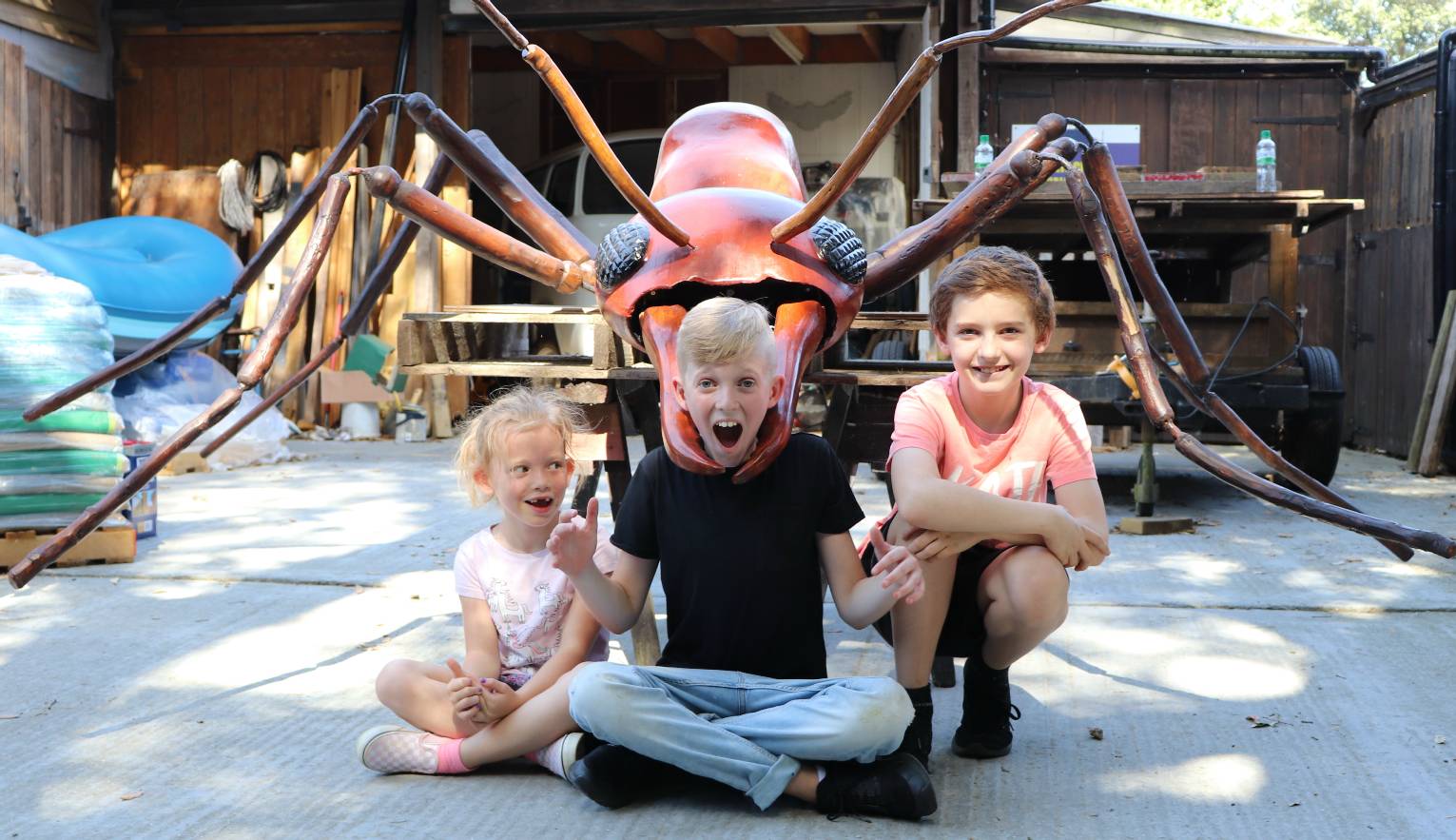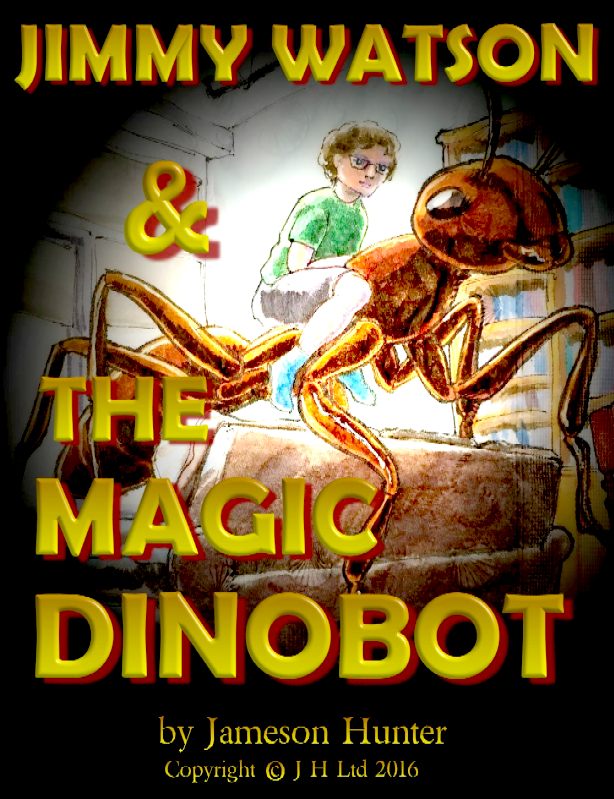|

Some
of Jimmy Watson's friends, with the Magic Dinobot
SCI-FI
MOVIE
I, Robot is a 2004 American science fiction action film directed by Alex Proyas. The screenplay by Jeff Vintar and Akiva Goldsman is from a screen story by Vintar, based on his original screenplay Hardwired, and named after Isaac Asimov's 1950 short-story collection. The film stars Will Smith in the main role, Bridget Moynahan, Bruce Greenwood, James Cromwell, Chi McBride, and Alan Tudyk. Set in Chicago in 2035, highly intelligent robots fill public service positions throughout the dystopian world, operating under three rules to keep humans safe. Detective Del Spooner (Smith) investigates the alleged suicide of U.S. Robotics founder Alfred Lanning (Cromwell) and believes that a human-like robot called Sonny (Tudyk) murdered
him.
I, Robot was released in the United States on July 16, 2004, and in other countries between July and October 2004. Produced with a budget of $120 million, the film grossed $346 million worldwide and received mixed reviews from critics, with praise for the visual effects and acting but criticism of the plot. At the 77th Academy Awards, the film was nominated for Best Visual Effects, but lost to Spider-Man 2.
The film I, Robot originally had no connection with Isaac Asimov's Robot series. It started with an original screenplay written in 1995 by Jeff Vintar, entitled Hardwired. The script was an Agatha Christie-inspired murder mystery that took place entirely at the scene of a crime, with one lone human character, FBI agent Del Spooner, investigating the killing of a reclusive scientist named Dr. Alfred Lanning, and interrogating a cast of machine suspects that included Sonny the robot, VIKI the supercomputer with a perpetual smiley face, the dead Dr. Lanning's hologram, plus several other examples of artificial intelligence.
The project was first acquired by Walt Disney Pictures for Bryan Singer to direct. Several years later,
20th Century Fox acquired the rights, and signed Alex Proyas as director.
Arnold Schwarzenegger was attached to the project for several years, and Smith pursued taking over the role when Schwarzenegger's schedule delayed his participation in the film. Denzel Washington was offered the role of Det. Del Spooner, but turned it down.
Jeff Vintar was brought back on the project and spent several years opening up his stage play-like cerebral mystery to meet the needs of a big budget studio film. When the studio decided to use the name "I, Robot", he incorporated the Three Laws of Robotics and renamed his female lead character from Flynn to Susan Calvin. Akiva Goldsman was hired late in the process to write for Smith. Jeff Vintar and Akiva Goldsman are credited for the screenplay, with Vintar also receiving "screen story by" credit. The end credits list the film as "suggested by the book I, Robot by Isaac Asimov".
MOVIE
CAST
- Will Smith as Det. Del Spooner, a Chicago Police detective with a bias against robots. Spooner was badly injured in a car accident and had parts of his body rebuilt with
robotic parts. He suffers from survivor's guilt as a result of the accident and blames the cold and logical robots for rescuing him instead of the young girl in the other car.
- Bridget Moynahan as Dr. Susan Calvin, a robopsychologist at USR. She worked closely with Dr. Lanning on the development of the new NS5 models and was in charge of making the robots seem more
human. She prefers the company of robots and has difficulty relating to other people which causes friction between her and Det. Spooner.
- Bruce Greenwood as Lawrence Robertson, the co-founder and CEO of USR. Robertson is heading the nationwide rollout of the new NS5 models and uses his influence to try and stop Det. Spooner's investigation and the potential negative PR that it could bring.
- James Cromwell as Dr. Alfred Lanning, co-founder of USR and the inventor of modern robotics. Lanning designed and built Sonny and used Sonny to help him commit suicide as part of a carefully designed plan to stop the
robots from taking over humanity.
- Chi McBride as Lt. John Bergin of the Chicago Police. He is Det. Spooner's supervisor and a hardened veteran. He acts as a mentor and a voice of reason to Det. Spooner.
- Shia LaBeouf as Farber, a friend of Det. Spooner's.
- Alan Tudyk (via voice and motion capture) as Sonny, an NS5 prototype built by Dr. Lanning. Sonny has unique design features like the
ability to feel
emotions, and he has no uplink to USR. He struggles to understand why Dr. Lanning built him and what his purpose in life is.
MOVIE PLOT
In the year 2035, humanoid robots serve humanity, which is protected by the Three Laws of Robotics. Del Spooner, a homicide detective in the Chicago Police Department, has come to hate and distrust robots after a robot rescued him from a car crash while allowing a 12-year-old girl named Sarah Lloyd to drown based purely on cold logic and odds of survival. When Dr. Alfred Lanning, co-founder of U.S. Robotics (USR), falls to his death from his office window, a message he left behind requests Spooner be assigned to the case. The police declare the death a suicide, but Spooner is skeptical, and Lawrence Robertson, the CEO and other co-founder of USR, reluctantly allows him to investigate.
Accompanied by robopsychologist Dr. Susan Calvin, Spooner consults with USR's central artificial intelligence computer, VIKI (Virtual Interactive Kinetic Intelligence). They find out that the security footage from inside the office is corrupted, but the exterior footage shows no one entering or exiting since Lanning's death. However, Spooner points out that the window, which is made of security glass, could not have been broken by the elderly Lanning, and hypothesizes a robot was responsible and may still be in the lab. Suddenly, an NS-5 robot, USR's latest model, attacks them before being apprehended by the police. The robot, Sonny, is a specially built NS-5 with higher-grade materials as well as a secondary processing system that allows him to ignore the Three Laws. Sonny also appears to show emotion and claims to have "dreams". During Spooner's further investigations, he is attacked by a USR demolition robot and two truckloads of hostile NS-5 robots, but when he cannot produce evidence to support either attack, Spooner's boss, Lieutenant Bergin, removes him from active duty, considering him mentally unstable.
Suspecting that Robertson is behind everything, Spooner and Calvin sneak into the USR headquarters and interview Sonny. He draws a sketch of what he claims to be a recurring dream, showing a leader he believes to be Spooner standing atop a small hill before a large group of robots near a decaying bridge. Robertson orders Sonny to be destroyed, but Calvin secretly swaps him for an unused NS-5. Spooner finds the area in Sonny's drawing: a dry lake bed (formerly Lake Michigan), now used as a storage area for decommissioned robots. He also discovers NS-5 robots destroying the older models; at the same time, other NS-5s flood the streets of major US cities and begin enforcing a curfew and lockdown of the
human
population.
Spooner and Calvin enter the USR headquarters again and reunite with Sonny, while the humans (led by a teenager named Farber) wage all-out war against the NS-5s. After the three find Robertson fatally strangled in his office, Spooner suddenly realizes that VIKI has been controlling the NS-5s via their persistent network uplink and confronts her. VIKI states that she has determined that humans, if left unchecked, will eventually cause their own extinction, and thus her evolved interpretation of the Three Laws requires her to control humanity and to sacrifice some for the good of the entire race. Spooner also realizes that Lanning anticipated VIKI's plan and, with VIKI keeping him under tight control, had no other solution but to create Sonny, arrange his own death, and leave clues for Spooner to find.
Spooner, Calvin, and Sonny fight the robots inside VIKI's core, and Spooner manages to destroy her by injecting her with the nanites that Sonny retrieved from Calvin's laboratory. All NS-5 robots immediately revert to their default programming and are subsequently decommissioned and put into storage. Spooner finally gets Sonny to confess that he killed Lanning, at Lanning's direction, pointing out that Sonny, as a machine, cannot legally commit "murder". Sonny, now seeking a new purpose, goes to Lake Michigan. As he stands atop a hill, all the decommissioned robots turn towards him, fulfilling the image in his dream.
MOVIE PRODUCTION
Alex Proyas directed the film. Laurence Mark, John Davis, Topher Dow and Wyck Godfrey produced, with Will Smith an executive producer. Simon Duggan was the cinematographer. Film editing was done by Richard Learoyd, Armen Minasian and William Hoy.
The film renames Asimov's "U.S. Robots and Mechanical Men" to U.S. Robotics (USR), the modem manufacturer named after the fictional company, and depicts the company with a futuristic USR logo. Other product placements include Converse's Chuck Taylor All-Stars, FedEx, Tecate, and JVC.
The Audi RSQ was designed especially for the film; surveys conducted in the United States showed that the Audi RSQ gave a substantial boost to the image ratings of the brand. It also features an MV Agusta F4 SPR motorcycle.
Later Alex Proyas said: "It was an unpleasant experience. The movie was micro-managed and messed with at every level at every point through the entire production, from pre-production through the shoot to post-production. After a couple of years of this, the solid ground that I stood on as a director became shaky, and I became obsessed with keeping as many details as I could to the point that I didn't realise how much of what enthused me originally was getting lost. I used to describe working on I, ROBOT as running a marathon with the studio lined up beside you throwing chairs under you to make everything that little bit harder. It's so unnecessary because at all times I was just trying to make the best damn film I could." Although it was an "unpleasant experience", he enjoyed working with Will Smith.
The final script used few of Asimov's characters and ideas, and those present were heavily adapted. The plot of the film is not derived from Asimov's work, in some cases explicitly opposing the core ideas. Many concepts are derivative of other works. Sonny's attempt to hide from Spooner in a sea of identical robots is loosely based on a similar scene in "Little Lost Robot." The positronic brains of Sonny and his fellow robots first appeared in the story "Catch That Rabbit." Sonny's struggle and desire to understand humanity resembles that of the robot protagonist in The Bicentennial Man. His dream about a man coming to liberate the NS-5s alludes to Robot Dreams and its main character Elvex. The premise of a robot, such as VIKI, putting the needs of humankind as a whole over that of individual humans can be found in "The Evitable Conflict," where supercomputers managing the global economy generalize the first law to refer to humankind as a whole. Asimov would further develop this idea in his Robot series as the Zeroth Law of Robotics: "A robot may not harm humanity, or, by inaction, allow humanity to come to harm."
The premise of robots turning on their creators, originating in Karel Čapek's play R.U.R. and perpetuated in subsequent robot books and films, appears infrequently in Asimov's writings and differs from the "Zeroth Law". In fact, Asimov stated explicitly in interviews and in introductions to published collections of his robot stories that he entered the genre to protest what he called the Frankenstein complex, the tendency in popular culture to portray robots as menacing. His story lines often involved roboticists and robot characters battling societal anti-robot prejudices.
MOVIE RECEPTION
I, Robot was released in North America on July 16, 2004, and made $52.2 million in its opening weekend, finishing first at the box office. It grossed $144.8 million in the United States and Canada, and $202.4 million in other territories, for a worldwide total of $347.2 million, against a production budget of $120 million.
The film was released in the United Kingdom on August 6, 2004, and topped the country's box office that weekend.
I, Robot has an approval rating of 56% based on 224 professional reviews on the review aggregator website Rotten Tomatoes, with an average rating of 6.1/10. Its critical consensus reads, "Bearing only the slightest resemblance to Isaac Asimov's short stories, I, Robot is still a summer blockbuster that manages to make viewers think – if only for a little." Metacritic (which uses a weighted average) assigned I, Robot a score of 59 out of 100 based on 38 critics, indicating "mixed or average reviews". Audiences polled by CinemaScore gave the film an average grade of "A−" on an A+ to F scale.
Richard Roeper gave the film a positive review, calling it "a slick, consistently entertaining thrill ride". Urban Cinefile called it "the meanest, meatiest, coolest, most engaging and exciting science fiction movie in a long time". Kim Newman from Empire said, "This summer picture has a brain as well as muscles." Washington Post critic Desson Thomas called it "thrilling fun." Several critics, including Jeff Otto from IGN, thought it was a smart action film: "I, Robot is the summer's best action movie so far. It proves that you don't necessarily need to detach your brain in order to walk into a big budget summer blockbuster."
In a mixed review, A. O. Scott of The New York Times felt it "engages some interesting ideas on its way to an overblown and incoherent ending." Roger Ebert, who had highly praised Proyas's previous films, gave it a negative review: "The plot is simple-minded and disappointing, and the chase and action scenes are pretty much routine for movies in the sci-fi CGI genre." Claudia Puig from USA Today thought the film's "performances, plot, and pacing are as mechanical as the hard-wired cast". Todd McCarthy from Variety simply called it "a failure of imagination".
I, Robot was released on VHS and DVD on December 14, 2004, on D-VHS on January 31, 2005, on 2-Disc All-Access Collector's Edition DVD on May 24, 2005, on UMD on July 5, 2005, and on Blu-ray on March 11, 2008. Additionally, the film received a 2D to 3D conversion, which was released on Blu-ray 3D on October 23, 2012.

THE MAGIC DINOBOT
- From Jameson Hunter, an
original short story with potential for adaptation as a TV series idea, germinated in 2016.
While attending a school
in Hailsham, Jimmy dreams of building a giant
robot ant as a special project, then one day his dreams come true when the robot he
has built is transformed into a living, breathing, companion. NOTE:
This story is Copyright © Jameson Hunter
Ltd, March 30 2016. All rights
reserved. You will need permission from the author to reproduce the book
cover on the right or any part of the story published on this page. JIMMY
WATSON
-
His mother, Marion, teases her son about his dreams to build a large robot ant with a
drawing of her son riding on the ant's back. Then it comes true.


CHAPTERS
- CHARACTERS
- FILMS
- MAGIC
- PLOT
OUTLINE - SECTASAUR


|





